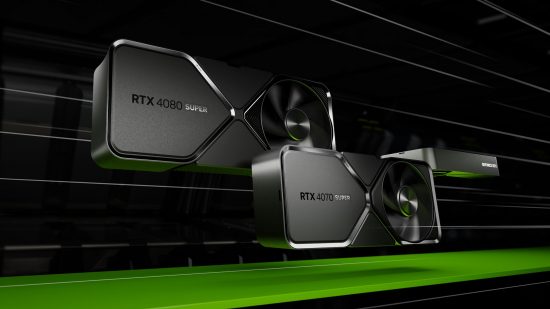The Nvidia GeForce RTX 40 series is ripe with options for all gamers, be they value-minded or after the highest performance possible. If you’re thinking of buying one of these graphics cards, we’ve pooled together everything you need to know about the green team’s latest GPUs.
Looking at our best graphics card list, you’ll see that Nvidia makes up the majority of it for good reason. The company’s GeForce RTX 40 series is not only more powerful than the previous generation, but also includes new features such as DLSS 3 that push frame rates even further.

How much do Nvidia GeForce RTX 40 series graphics cards cost?
You can expect to pay at least $299 for an RTX 40 series graphics card, but the most expensive option from Nvidia tops has a much more costly base price of $1,599.
- Nvidia GeForce RTX 4090 – $1,599
- Nvidia GeForce RTX 4080 – $1,199 (Discontinued)
- Nvidia GeForce RTX 4080 Super – $999
- Nvidia GeForce RTX 4070 Ti Super – $799
- Nvidia GeForce RTX 4070 Ti – $799 (Discontinued)
- Nvidia GeForce RTX 4070 Super – $599
- Nvidia GeForce RTX 4070 – $549
- Nvidia GeForce RTX 4060 Ti 16GB – $499
- Nvidia GeForce RTX 4060 Ti 8GB – $399
- Nvidia GeForce RTX 4060 – $299
Sitting slap bang in the middle of the RTX 40 series product stack, we recommend that most people opt for the RTX 4070 Super. While slightly more expensive than the RTX 4070 by $50, the newer Super graphics card is markedly more performant and presents better overall value.
If your budget is limited, the RTX 4060 is your only real option. Don’t beat yourself up about not being able to stretch to either of the RTX 4060 Ti models, as present a significant enough uplift to justify the $100 price differential (particularly the 16GB version).
Should you be lucky enough to be able to afford the RTX 4090, there’s simply nothing else like it on the market. However, the RTX 4080 Super is certainly worth a look, as that $600 difference could be spent upgrading your setup elsewhere and you’ll still have plenty of performance to enjoy.

What are the specs of GeForce RTX 40 series graphics cards?
The GeForce RTX 40 series is built using Nvidia’s Lovelace architecture, featuring third-generation RT Cores for enhanced ray tracing performance and fourth-generation Tensor Cores to accelerate AI-driven features such as DLSS.
The most powerful graphics card in the GeForce RTX 40 series in the RTX 4090 which features the most powerful GPU in the Lovelace arsenal, AD102. As such, it comes equipped with the highest number of RT Cores (128), Tensor Cores (512), and CUDA Cores (16,384) that you’ll find in an Nvidia graphics card. It also features a staggering 24GB of GDDR6X VRAM, making it more than suitable for even the most demanding of games at 4K.
As you move down the stack, specifications will naturally become less powerful. However, it’s better to focus on performance primarily before thinking too much about a graphics card’s technical makeup.

In our benchmarks, Nvidia GeForce RTX 40 series GPUs beat the competition from AMD in games with ray tracing enabled. While their standard rasterization frame rates are competitive, they do lose some ground in this type of rendering. That said, DLSS 3 provides a higher quality upscaling and frame generation suite, to boost performance.
Check out our reviews for each Nvidia GeForce RTX 40 series graphics card for more detailed information on how they perform. We’ve tested each of them at 1080p, 1440p, and 4K, both with and without ray tracing.
Here are our Nvidia GeForce RTX 40 series reviews:
- Nvidia GeForce RTX 4060
- Nvidia GeForce RTX 4060 Ti 8GB
- Nvidia GeForce RTX 4070
- Nvidia GeForce RTX 4070 Super
- Nvidia GeForce RTX 4070 Ti
- Nvidia GeForce RTX 4070 Ti Super
- Nvidia GeForce RTX 4080
- Nvidia GeForce RTX 4080 Super
- Nvidia GeForce RTX 4090

Where can I buy Nvidia GeForce RTX 40 series graphics cards?
Nvidia GeForce RTX 40 series graphics cards are available from major retailers such as Amazon, Best Buy, and others, as well as directly from Nvidia itself.
Here are some great deals on GeForce RTX 40 series graphics cards right now:
Be sure to check our best graphics card guide to learn more about alternatives to the GeForce RTX 40 series from both AMD and Intel, featuring additional summaries and reviews.
